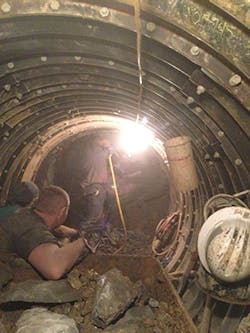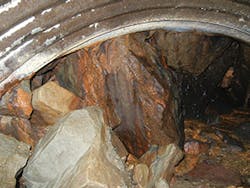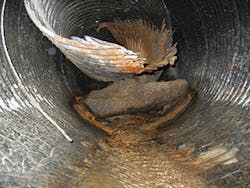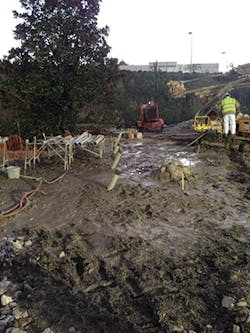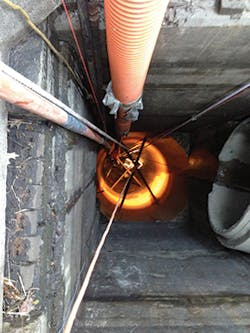Stopping a Sinkhole: Examining the Pipe (Part 2)
Editor’s note: In part one of this three part series on Stopping a Sinkhole, we looked at how a sinkhole is formed and the first steps stormwater professionals took to assess the damage. In Part 2, we look at how the repair team assessed the scope of the repair project. As future installments are published, we will update this story with links. If you’d like to read the complete article today and are a subscriber to the online version of Stormwater Magazine, visit this page. Or, sign up for a free subscription here.
The Painful Process of Discovery
Rodney Blackmon, executive vice-president and general manager of Video Industrial Services, says the company’s reputation and range of services for “tough projects like this” made it a good choice for both diagnosing and helping to fix the stormwater system damage at The Summit.
Video Industrial is an affiliate of Carylon Corporation, a Chicago-based company that specializes in multiple maintenance services to help municipalities, utilities, and industries with environmental compliance. The company has a played a role in assisting local efforts to manage diverse events such as the flooding of the Chicago Loop from a breached underground tunnel, numerous floods and hurricanes across the Gulf Coast, cleanup at the 9/11 World Trade Center disaster, and many others.
“We do all kinds of cleaning, dewatering, and sludge removal, and our video inspection services in this case were absolutely key to the cleanup and repair strategies of the pipe collapse,” says Blackmon. “When we were first called by Charles Malone at the Alabama DOT, we thought it was a sewer line that had washed out part of a pipe, thinking that eventually the pressure pushed the pipe in, and when that fell in, it sealed up the pipe. Naturally, the pond would start filling up.”
He says the first step prior to any camera inspection was to gain access to the pipe system. Crews pumped water from the sinkhole on the Summit side, but soon after that there was a massive rainstorm.
“We had our little pump going, and it wouldn’t touch that amount of water,” he says.
“At this point Malone was trying to get contractors lined up, because he knew that the sewer had collapsed. This new storm came in and washed out part of the detention pond’s earthen dam, and it flushed huge rocks and debris out, which ended up closing one of the roadway exits. If the whole dam had washed away it would have hit the highway and pushed cars off into the ravine. In just a couple of hours it was overflowing like crazy,” says Blackmon.
However, no work strategy could be planned until the video inspection assessed the entire system, which by necessity had to be done in piecemeal efforts as obstructions had to be cleared in stages.
Getting the Real Picture of Problems
This process was literally an eye-opener to the extent of the problem. Philip Bell, division manager at Video Industrial Services, describes the view when crews examined the outflow on the AT&T end.
“A lot of rocks had come down the pipe,” he says. “When we got into the storm pipe, it was 80% full and blocked at the outfall. There was a very small air gap.”
He explains that typically crews can use high-pressure water-jetting equipment to clear away water and debris. “These machines are designed to flush out a manhole then extract the water and debris, but we couldn’t do that here because we couldn’t disturb the lake water on the AT&T side, since it’s used for chiller water. We could not create any turbidity, which further restricted our efforts.”
The company instead used industrial vacuum trucks. “We moved yards of material,” says Bell. “We would normally take these very large rocks out in the day and the smaller stuff at night. We were working day and night and we had to be careful to not scratch any of the property trees on the AT&T side, although we did have to take a few down.”
Crews put the camera in as far as they could, but after a few hundred feet the space was too small to go farther, so the next stage involved pumping down the upper inlet, putting the camera on a float, and pushing it in downstream.
“Right past the junction pipe there was a big, twisted piece of corrugated storm pipe that was up inside the line. It had elongated, curled up, and was wedged in place,” says Bell. He adds that the pipe had stopped 150 feet from where it had come loose.
Removing this source of the problem was essential to any further work, so after cleaning around the pipe to free it up, crews burned holes into the metal, put in a clevis, and using a very powerful winch, pulled it free and out of the line.
“You can’t hurry in a situation like this,” says Bell. “We were mindful of the timetable, but you can’t put people in jeopardy. We talked to our company president to advise him what we were doing, and his advice in this—and any—project was ‘None of us is as smart as all of us,’ and he’s right; you need a lot a lot brains to weigh every possible hazard. We were very fortunate in that no one was hurt, but we do everything we can to minimize those risks.”
In the meantime, all work being done was subjecting the workers to water, and keeping the pond pumped down was essential to keep them safe from the hydraulic pressure of the groundwater and stormwater. Malone says they had access to a ditch, so the pumps took the water out of the pond and carried it farther down to a safe level.
Throughout this initial cleanup, Malone says, his other priority was “to keep the road safe.”
He says, “We got an emergency authorization letter signed by the state transportation board, which allowed us to seek bids for repairs.” Russo Corporation, a firm serving southeast states from Arizona to North Carolina and specializing in site work, foundation drilling, injection technologies, and underground utilities, was awarded the project.Editor’s note: In part one of this three part series on Stopping a Sinkhole, we looked at how a sinkhole is formed and the first steps stormwater professionals took to assess the damage. In Part 2, we look at how the repair team assessed the scope of the repair project. As future installments are published, we will update this story with links. If you’d like to read the complete article today and are a subscriber to the online version of Stormwater Magazine, visit this page. Or, sign up for a free subscription here.
